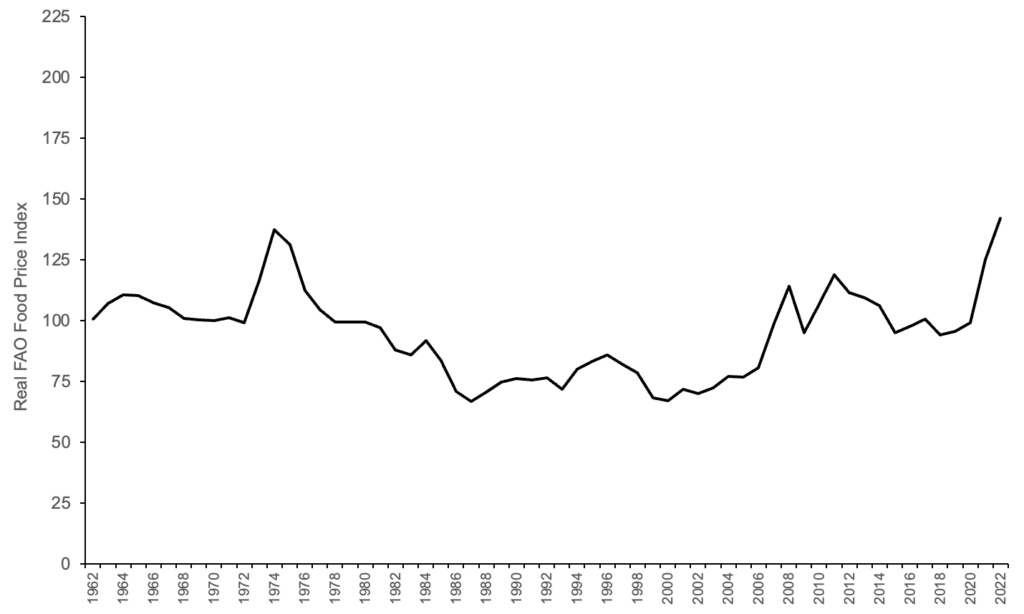The UN’s Food and Agricultural Organization tracks food prices around the world via its Food Price Index. This is calculated as the average of five commodity group price indexes, weighted by their shares of global exports in the years 2014–2016. The five commodity groups are: cereals, vegetable oils, dairy, meat and sugars.
It’s important to note: the index doesn’t directly guage the price of food in the shops; it measures the price of food commodities. The former varies from country to country, and depends on factors like local regulations and supply chain issues. But generally speaking, if the Food Price Index rises, the price of food in the shops will rise too.
The chart below plots the index from 1962 to 2022, based on inflation-adjusted prices. The figure given for 2022 is the average for the first three months of the year.

As you can see, the index is currently at its highest ever level. In fact, the value for March (the latest available) was 159, compared to ‘only’ 136 in January – meaning the index has continued to rise over the past three months.
The last time food prices were as high as they are now was during the 1970s oil crisis. In 1973, OPEC imposed an oil embargo against countries that had backed Israel during the Yom Kippur War. This led to a quadrupling of the price of oil, with knock-on effects in other areas of the economy, including food production.
What explains the recent uptick? Well, the first major culprit is the pandemic, and more specifically lockdowns, which caused immense disruption to global supply chains. (Note: since the chart above is based on inflation-adjusted prices, the changes can’t be explained by loose monetary policy.)
The second major culprit is the war in Ukraine, which has put substantial upward pressure on food prices since February. Ukraine and Russia are major supplies of not only wheat, but also sunflower oil and fertilizer.
The combination of sanctions, disruptions caused by the conflict itself, and Russia’s self-imposed export ban, has reduced the volume of exports reaching global markets. And these effects have been compounded by the rising cost of natural gas – a major input to fertilizer production.
The resulting uptick in global food prices has the potential to cause famines throughout North Africa, the Middle East, and other regions that are heavily dependent on wheat imports. The UN’s World Food Programme has warned that 2022 will be a year of “catastrophic hunger”.
“Pockets of famine” have already been reported in Somalia, a country that typically imports 100% of its wheat from Ukraine and Russia.
It’s possible that widespread famine can be averted if more crops are planted in countries with extra capacity, to compensate for the loss of exports from Ukraine and Russia. However, with the price of fertilizer as high as it is, alternative supplies are by no means guaranteed.
All of which raises the question: why did the West not seek a diplomatic solution as soon as the war in Ukraine began? Yes, this could be seen as ‘rewarding Putin’s aggression’, but the costs of ‘not feeding millions of people’ could be much greater. Add the risks of nuclear escalation, and the West’s current approach becomes increasingly hard to understand.










To join in with the discussion please make a donation to The Daily Sceptic.
Profanity and abuse will be removed and may lead to a permanent ban.
Oh FFS they weren’t vaccines.
Of course they’re not going to reduce mortality.
When are you “experts” actually going to catch on?
Mistakes weren’t made. It was a deliberate cull.
Indeed. And what is this “pandemic” of which he speaks?
Exactly. And besides, name an actual vaccine for a respiratory disease which works. Nothing’s changed, they’ve just made them deadlier by orders of magnitude. ”Deliberate cull” indeed.
Culling aside, it helps legitimise widespread use of a new technology that, in November 2018, was expected to be “several years away from being tested in the U.S.”. Those several years to reach testing turned out to be very pessimistic.
https://web.archive.org/web/20220515130615/https://www.pfizer.com/news/articles/new_rna_technology_could_get_the_flu_vaccine_right_every_year
Pfizer removed the November 30 2018 date from this article circa mid 2021 so it isn’t shown on the web archive. Dates tend to be helpful on news articles so an unusual piece of information to remove.
This new technology was also legitimised by attempts to discredit alternative treatments and prevention, including vitamin D and HCQ. The medical establishment’s “relentless war” against HCQ is covered in this documentary (also featuring Dr. Peter McCullough) from 46:31:
Covidism: The Contagious Deception – 2023 Documentary – Part I – The White Rose
See also from 51:55 for the Rome Declaration concluding that this war constitutes “possible crimes against humanity”.
Historically, the medical establishment has also conducted a similar war against laetrile (used for cancer prevention and cure), thus leading to the banning of apricot kernels (a laetrile source) being sold as a food in the EU. The unethical practices of the pharmaceutical industry have been known for a long time. See for example this piece in the Independent from 2014 by Oliver Wright (now policy editor for the Times muppets):
Big Pharma lobbyists exploit patients and doctors | The Independent | The Independent
Also here:
Revealed: Big Pharma’s hidden links to NHS policy, with senior MPs saying medical industry uses ‘wealth to influence government’ | The Independent | The Independent
(Refresh page to show full article?).
Instead of sorting this out, our politicians have enabled a medical scandal far worse than anything that could have been imagined back in 2014. Is it going too far to suggest our politicians and msm who failed to pursue this story (including the Times muppets) have been criminally negligent or worse? Never forget what they have done to us.
Digging deep in to the nuances of 1918 and the Spanish Influenza that allegedly killed 50 million, one may come to the conclusion that this isn’t the first time.
Please listen to this Danish doctor talking about early studies into the effectiveness of traditional vaccines and the effect of using live against dead viruses in the vaccines.
https://www.youtube.com/watch?v=o_nKoybyMGg
Managed to slip back into the Overton window by a whisker.
Indeed. And there was no bloody pandemic. Just a bad flu season.
Do you intend to say that on every single Covid-related article?🤔
Don’t know why you have so many downticks – I presume you were being gently humorous.
I suppose I sound like a broken record but IMO it bears repeating. Fundamentally the problem with what happened with covid isn’t that masks and lockdowns and “vaccines” didn’t work as advertised, the problem is that the event (if there was one) was well within what had been accepted norms for living with such infectious diseases by carrying on as normal. That contract has been broken and unless and until that understanding is restored, we are in danger. I don’t see this view repeated enough above the line.
How aboiut almost completely ineffective “vaccines”?
According to a Pfizers own document dated Jan 2021 (released due to a FOI request) there was zero difference in lung inflammation of Covid infected Macaques whether “vaccinated” or not.
Considering Covid is a Respiratory virus I’m willing to drop the “almost”
Here is another view supplied by the Johns Hopkins University of Medicine
They recorded cases, deaths and vaccine numbers for all countries, although the accuracy and choice of scale was questionable. Either way, there is a picture here particularly the timing of the ‘vaccines’ and the 3rd wave. Denmark used 3 different ‘vaccines’: Johnson & Johnson; Oxford A/Z; Pfizer BioNtech
Compare these graphs with those for all previous respiratory outbreaks such as the Spanish Flu, where there were usually 1 or 2 waves with all subsequent waves being lower and disappearing.
Red = Cases
White = Deaths
Green = Vaccine doses
Safe jabs don’t have excess deaths
************************************
Stand in the Park Make friends & keep sane
Sundays 10.30am to 11.30am
Elms Field
near play area
Wokingham RG40 2FE
The ONS generated a report that draws the same conclusions but for political reasons could not state it;
https://open.substack.com/pub/sandrews/p/office-of-national-statistics-ons?utm_source=share&utm_medium=android